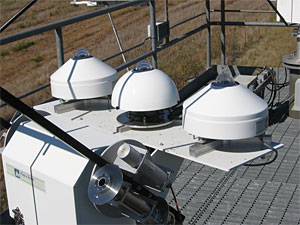
Scientists use an assortment of sophisticated remote-sensing instruments to obtain measurements of cloud and other atmospheric properties for climate research. A pyranometer is an instrument that measures how much solar radiation is scattered by molecules and particles in the atmosphere. The pyranometer is mounted to “solar trackers” that follow the path of the sun, continuously blocking the direct sunlight so that only diffuse irradiance (skylight) is measured by the instrument. This measurement is critical for validating cloudy-sky, as well as clear-sky radiative transfer codes used in global climate models. However, diffuse irradiance does not currently have an absolute standard such as the absolute cavity radiometer used to measure direct solar radiation. For nearly 2 weeks in October, the ARM Southern Great Plains (SGP) site hosted a collection of four pyranometers on two solar trackers to compare their measurements and ultimately define a diffuse irradiance working standard for ARM.
The goal of the diffuse irradiance study was to obtain simultaneous measurements with well-characterized, shaded pyranometers, pre-selected based on past performance in two previous diffuse irradiance studies held in September and October of 2001 and in October 2003. All pyranometers used in the current study were characterized in the laboratory for angular and spectral response prior to the start of the two-week study. Based on their performance, ARM scientists hope to select a set of these pyranometers that will establish a working standard of diffuse horizontal shortwave irradiance for the ARM science team. Though this measurement has vastly improved in recent years, biases remain that researchers expect to resolve with results from the diffuse irradiance study.

